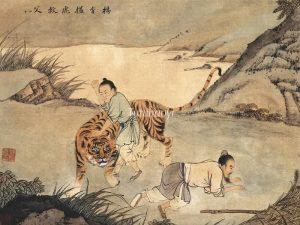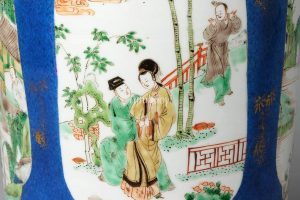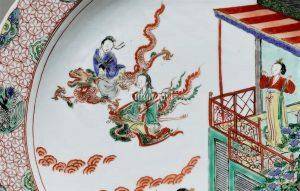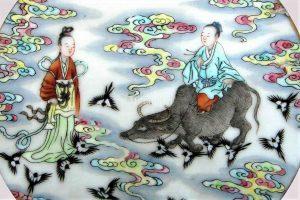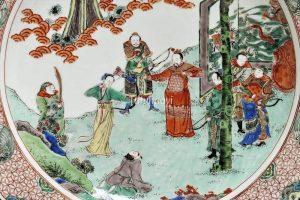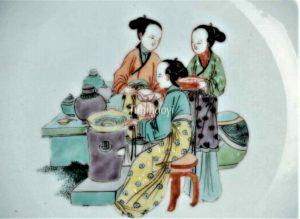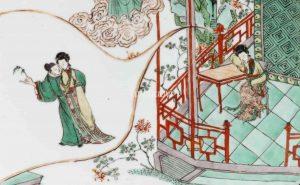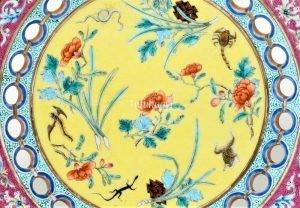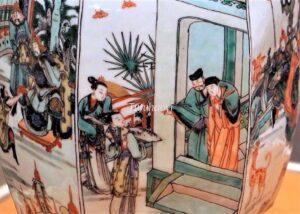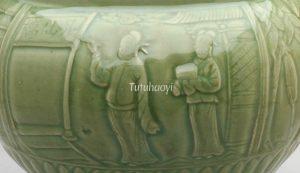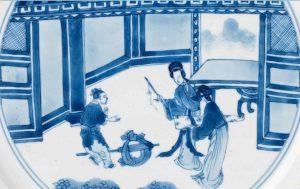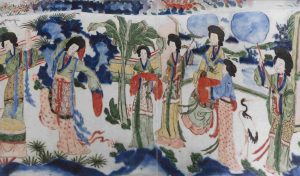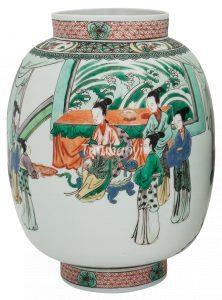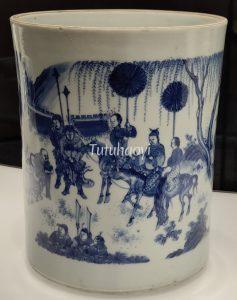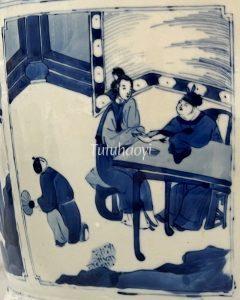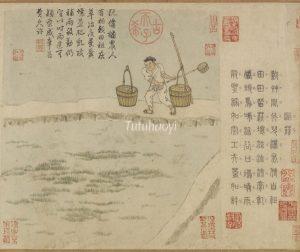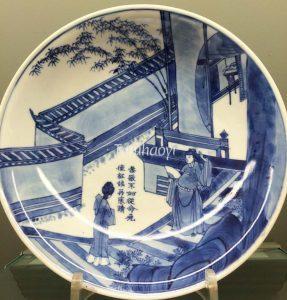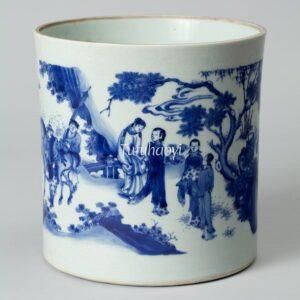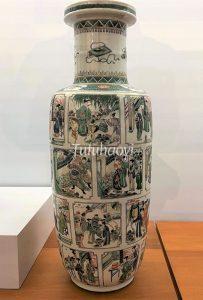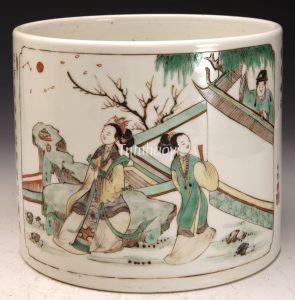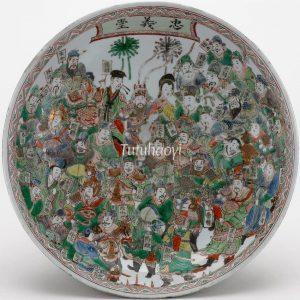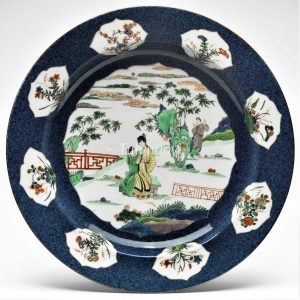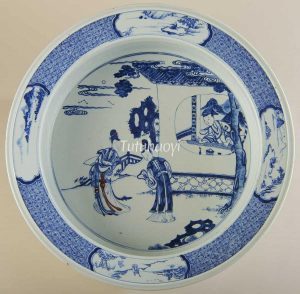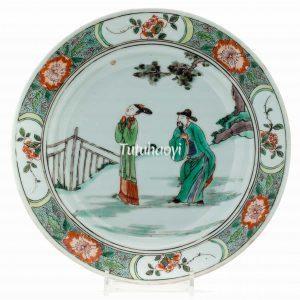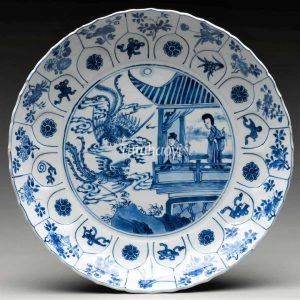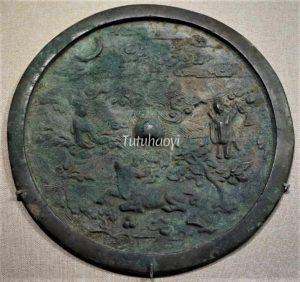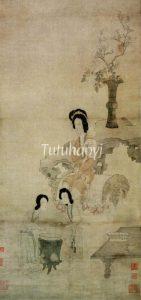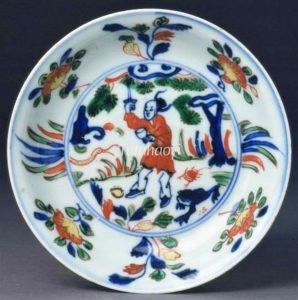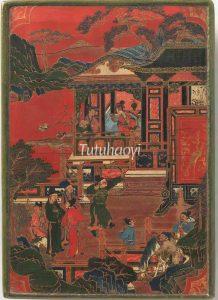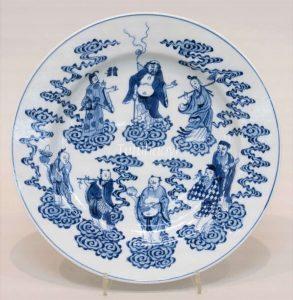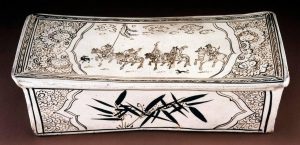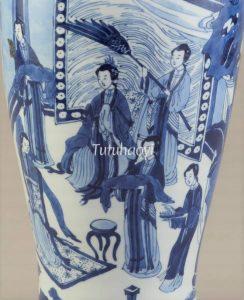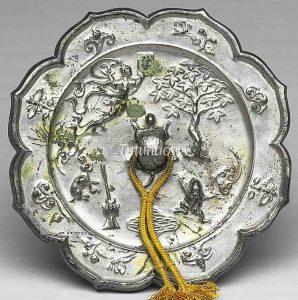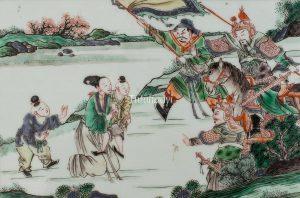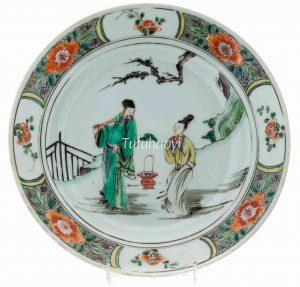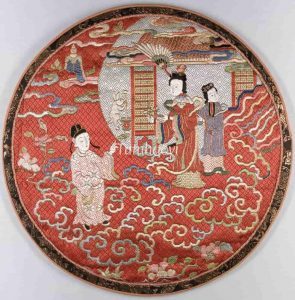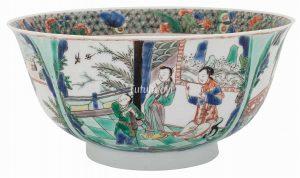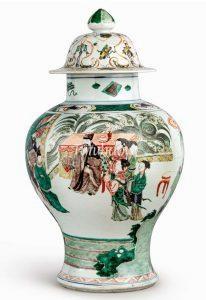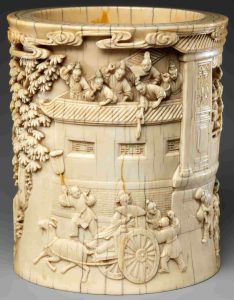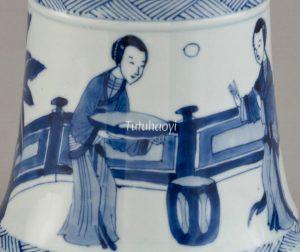Showing Results Containing
The Chinese Valentine’s Day, Qixi Festival (七夕节), is just around the corner. It falls on the seventh day of the seventh month of the traditional Chinese year. Dr Yibin Ni has conducted comprehensive research on this topic and has written an articl...
‘Imperial Consort Lady Yang Getting Drunk’ has been a popular Chinese story plot since the seventeenth century. However, many renowned museums are still not able to identify this story scene on the porcelains in their collection. Dr Yibin Ni will ...
‘Yang Xiang trying to throttle the tiger to rescue her father’ is a well-known story passed down from generation to generation in ancient China. However, Yang Xiang has sometimes been portrayed as a male figure on traditional Chinese artworks. Let...
The story scene comes from a marvel play Legend of the Jade Hairpin, which is not to be confused with the scene in Romance of the Western Chamber. Read the following article to find out details of the story and how this figural scene is depicted.<...
Chinese people deeply respect the elderly and traditionally consider a long existence to be one of the most important blessings in a person’s life. Here are many examples of how artists have combined a variety of longevity symbols to reinforce the...
In Chinese culture, the Mid-Autumn Moon Festival is related to the legendary fairy Chang E, the Moon Goddess. We often see a hare, her loyal companion, and an osmanthus tree in the picture with her against a background of the Moon Palace. However,...
Correctly identifying figures is crucial to deciphering an obscure story scene. Looking at this featured image, for example, some may think that the two figures in non-specific attires on a dragon and a phoenix are anonymous Daoist immortals. But ...
On the seventh day of the seventh month of the lunar Chinese year, young men and women will celebrate their traditional ‘Valentine’s Day’, Qixi Festival (七夕节). The custom can be traced back to an ancient story.
Congratulations on art historian Dr Yibin Ni’s new research into a rare story scene in Chinese pictorial art, which may have puzzled contemporary museum curators and porcelain collectors. Dr Ni has traced the art historical context in which this r...
Pictorial artworks with figural scenes in traditional China often have historical and cultural significance and are not to be mistaken for daily life genre painting. Here is an example and Dr Yibin Ni will explain to you the hidden meaning in the ...
The Peony Pavilion is a famous play written by Tang Xianzu in Ming Dynasty. There are very few figural paintings depicting this play on Kangxi famille verte porcelain. Dr Yibin Ni first identified the figures and the scene on a porcelain dish in t...
On Duanwu Festival, Chinese people have a variety of practices, such as drinking rice wine sprayed with realgar powder and hanging images of the Heavenly Master on the lintel. Where did this tradition come from and how were these practices depicte...
This is a republication of Dr Yibin Ni’s article written in Chinese “明末清初瓷器上张生的‘凝视’和莺莺的挑战”(Gaze from Scholar Zhang and the response from Lady Cui Yingying: a discussion of figural depiction on porcelains from Late Ming to Early Qing dynasty)...
This blog is modified from Dr Yibin Ni’s research work first published on Antiques and Fine Art Magazine. The purpose is to appreciate how Chinese porcelain painters from ancient times passed on classical stories and illustrated traditional morals...
European descriptions of porcelain paintings that have story scenes tend to describe ‘figures and surroundings’, rather than identifying them. Thus, a large part of those beautiful stories intended by pot painters was lost in the description. Here...
Have you wondered why the same story scenes were painted differently on Chinese artworks? How was it painted to present women falling in love on Chinese antique porcelains? Read on to see what Dr Yibin Ni has to say with his analysis.
Mr Henk B. Nieuwenhuys from the Netherlands is the first foreigner who has kindly donated his art collection to China. Here are short video clips from a documentary made for this special event, in which Dr Yibin Ni was invited to introduce Nieuwen...
Do you wonder why there is a goat drawing a carriage, rather than a horse, on traditional Chinese art pictures? Why are there so many people watching someone in a chariot? What is the story behind it? Here is what Dr Yibin Ni has to tell you.
This is an overview by Dr Yibin Ni on how the topic of ‘The Birthday Party of the Queen Mother of the West’ was depicted on Chinese artworks, from woodblock print during Ming dynasty to scroll painting and porcelains in Qing dynasty.
The story of Cai Xiang’s building of the Luoyang Bridge comes from a popular play in the Ming dynasty. It blends history with legend. In the Northern Song, Cai Xiang—renowned calligrapher and prefect of Quanzhou—undertook the building of the Luoyang Bridge. The project took seven years to complete and has stood for nearl...
The earliest record of imperial consort Lady Yang (Yang Yuhuan 杨玉环, 719–756) and her fondness for lychees appears in the Supplement to the History of the Tang State (《唐国史补》), written by L...
Legend of the Epiphyllum (Tanhua Ji 昙花记) is a late Ming dynasty drama written by the accomplished scholar Tu Long (屠隆, 1542–1605), composed during the Wanli reign. Renowned for his achievements in literature, art, and Buddhist philosophy, Tu Long described this legendary play as a work intended ‘to expound the l...
This scene opens the first act of Romance of the Western Chamber and establishes the historical setting while introducing the principal characters.
The fe...
This is Scene Four of Act Three of The Romance of the Western Chamber (Xixiang Ji 西厢记), a popular Chinese drama written by playwright Wang Shifu 王实甫 (12...
The Gengzhi Tu (耕织图, Pictures of Tilling and Weaving) was first created during the Shaoxing era of the Southern Song dynasty (12th century) by Lou Shu, a magistrate of Yuqian County. It comprised 21 Tilling Scenes and 24 Weaving Scenes, combining poetry and illustrations to systematically document agricultural a...
This is Scene Two of Act Two of the Chinese classic drama Romance of the Western Chamber (西厢记 Xixiang Ji), written by the Yuan playwright Wang Shifu (1250–1336)....
The Legend of the White Snake is one of China’s four great folktales, the others being Lady Meng Jiang, Butterfly Lovers, and The Cowherd and the...
This is from Scene Two of Act Four of the Chinese popular drama Romance of the Western Chamber (西厢记 Xixiang Ji).
Miss Cui Yingying 崔莺莺 and Zhang Junrui (张君瑞, also called Scholar Zhang 张生) were deeply in love. Yingying’s maid, Hongniang 红娘, frequently escorted her to Scholar Zhang’s study Continue Reading
This is Scene three of Act Four of The Romance of the Western Chamber (Xixiang Ji 西厢记), a famous Chinese drama written by playwright Wang Shifu 王实甫 (1250–1336) in Yuan dynasty.
Zhang Gong 张珙 (styled Junrui 君瑞, also known as Scholar Zhang), and Madame Cui’s daughter, Cu...
This is Scene Four of Act Four of The Romance of the Western Chamber (Xixiang Ji 西厢记), a famous Chinese drama written by playwright Wang Shifu 王实甫 (1250...
The Chinese classic drama Romance of the Western Chamber (西厢记) depicts a romantic story of a young couple in the Tang dynasty. The name of the play has also been translated into The Story of the Western Wing, The West Chamber, and Romance of the Western Bower, etc. It stands as one of ...
This is from Scene Three of Act Three of the Chinese classic drama Romance of the Western Chamber (西厢记 Xixiang Ji), written by playwright Wang Shifu 王实甫...
This is from Scene Three of Act One of the Chinese classic popular drama Romance of the Western Chamber (西厢记 Xixiang Ji), written by the Yuan playwright Wang Shi...
Water Margin, also known as Outlaws of the Marsh or All Men Are Brothers, is a classic Chinese novel written during the Ming Dynasty. It is considered one of the Four Great Classical Novels of Chinese literature.
The authorship of the Water Margin has always been a subject of de...
This story scene originates from one of the four famous romantic plays in Yuan dynasty, Pei Shaojun on horseback meeting Li Qianjin over the garden wall (also known as On Horseback and over the Garden Wall) 裴少俊墙头马上, which was written by playwright Bai Pu (白朴 1226 – after 1306).
Pei Shaojun ...
This scene is from one of the most famous Chinese dramatic works, Romance of the Western Chamber 西厢记, which was written by the Yuan playwright Wang Shifu (王实甫 12...
This scene was from a popular play ‘The Story of the White Hare’ (Bai Tu Ji 白兔记) and was much admired during the Ming dynasty.
Liu Zhiyuan 刘知远, the hero of the play set during the turbulent Five Dynasties (907–960), became an orphan when he was a teenager. His affluent neighbour looked after him and later...
Dong Zhuo (董卓 d. 192), a tyrannic warlord rising to power at the end of the Han dynasty, caused great concern among courtiers and officials. Wang Yun (王允), the Minister Over the Masses (司徒 Situ), was entrusted to figure out a plan to bring him down. Dong Zhuo was particularly powerful because he managed to ally ...
The play Polishing the Dust-covered Mirror (磨尘鉴 Mo Chen Jian) was compiled in 1619 by an obscure playwright Niu Ge (钮格), according to some twentieth-century researchers, including the eminent scholar of the field Zheng Zhenduo (郑振铎 1898–1958). The play portrays some colourful historical figures of the T...
Early in Jin dynasty (晋 265–420), Yang Feng 杨丰 and his teenage daughter, Yang Xiang 杨香, were harvesting the millet crops in the fields when he was attacked by a tiger. Th...
Legend of the Jade Hairpin (Yu Zan Ji 玉簪记) is a Ming-dynasty ‘marvel play’ which was the major drama genre of the time. The play, consisting of thirty-three scenes, was written by Gao Lian (高濂 fl. 1573-1581) around 1580 and remained to be a popular classic for the following three hundred years. It is a Shakespea...
This is Scene Five of Act Two of the Chinese classic popular drama Romance of the Western Chamber (西厢记 Xixiang ji).
At a family dinner party, Zhang Junrui...
This is a scene from a popular traditional play ‘A Set of Interlocking Stratagems (连环计)’.
The war lord Dong Zhuo (董卓, ? – 192 CE) became a senior minister in the Han court. His tendency to dominate the young sovereign, Emperor Xian of Han (汉献帝, 181–234 CE), gave other ministers cause for concern. They asked Wang Y...
Duke Mu of the Qin State (秦穆公, died 621 BCE) was one of the so-called Five Hegemons (五霸 wuba) in the Spring and Autumn Period (770 – 476 BCE) (春秋 chunqiu). He had a daughter named ‘Nongyu (弄玉, meaning Playing Jade)’, who was a talented musician excelling at playing the sheng (笙 mouthorgan...
The seventh day of the seventh month of the traditional Chinese year is the Chinese ‘Valentine’s Day’, Qixi Festival (七夕节). The custom can be traced back to an ancient story about a weaver girl and a cowherd:
Once upon a time, one of the daughters of the Lord of the Heaven lived on the east side of the Mi...
‘Tiao Mei He Geng 调梅和羹’ is a metaphor that likens the art of governing a country to the adequate seasoning of a stew with salt and sour prunes. The scene is often made up of a group of women or men surrounding a stove, on which a cauldron of food is being cooked, with an assistant holding a container with sour p...
‘True love conquers all’ is the theme of the Peony Pavilion (牡丹亭 Mudan Ting), a musical play of fifty-five scenes written by Tang Xianzu (汤显祖, 1550–1616) in Ming...
This scene is an episode from the Ming drama ‘The Story of the Girl Holding ...
The Ming-dynasty play The Story of the Blue Robe (青袍记 Qingpao ji, also called《梁氏父子传胪记》) tells the story of how Lv Dongbin (吕洞宾 Lü Dongbin or 吕纯阳), one of the Continue Reading
In traditional Chinese customs, the fifth day of the fifth month of the lunisolar calendar is regarded as one of the most dangerous days of the year when evil spirits and hazardous creatures lurked around. Notably, five noxious creatures were identified, known as ‘Continue Reading
Li Yuan (李渊 566–635 CE) excelled at horse-riding, archery, and calligraphy as a young man. He was to be the future founder (reigned 618–626 CE) of the Tang dynasty (618–907 CE). Miss Dou was exceptionally smart and her father Dou Yi 窦毅, the governor of Dingzhou, was very particular about the quality of his future son-in-...
Romance of the Western Chamber (西厢记 Xixiang ji) is the most popular love comedy in late imperial China. In the story, Scholar Zhang (张生 Zhang Junrui) falls in love with a beautiful lady named Cui Yingying (崔莺莺), who happens to be stranded in a monastery with her widowed mother and, after plenty of twist...
Emperor Yang of the Sui dynasty (隋炀帝, r. 606-18) is known for many achievements, such as linking the Yellow and Yangzi Rivers with the man-made Grand Canal, leading successful military campaigns expanding the Sui territory, and being accomplished in the arts. Despite those, Emperor Yang is also considered to have brought...
Wang Zhaojun (王昭君, c.52 – c.15 BCE) was one of the court ladies in the harem of Emperor Yuan of the Western Han dynasty (汉元帝, 206 BCE – 8 CE). It was not possible for the emperor to meet every one of the three-thousand concubines, so he had a court painter paint their pictures to facilitate his selection process. Every l...
In Zhuangzi (庄子), an ancient Chinese text from the late Warring States period (476–221 BCE) and one of the two foundational texts of Daoism, the Queen Mother of the West (Xiwangmu 西王母) was mentioned as a deity who ‘obtained the Dao (the Way)’. According to the Scripture of Great Peace (Tai...
The Mid-Autumn Moon Festival falls on the night of full moon in the eighth lunar month. Chang’e, the Moon Goddess, is usually associated with this family-union occasion, together with the festival food – the moon cake (月饼). A legend recorded in an ancient Chinese book, The Huainanzi (淮南子 The Discourses of the Hu...
This is a story of a righteous woman. As the army of the state of Qi (齐国) launched an invasion against the state of Lu (鲁国), soldiers approaching a Lu suburb saw a woman struggling along the road with two children. When the army got closer, she abandoned one of the children and grabbed the other, moving toward the mounta...
Qiuhu (秋胡), a native of the state of Lu during the Spring and Autumn period (770-476 BCE), was ordered to take up an official post in the state of Chen a scant five days after his marriage to Jiefu (洁妇), the ‘Loyal Wife’. Five years later, on his way back home, he encountered a woman by the roadside picking mulberry leav...
‘Sima Xiangru Inscribing on the Bridge Gateway (相如题桥)’ was a popular theme in theatre from at least the Song (960–1279) through to the Qing (1644–1911) dynasty. Sima Xiangru (司马相如) was a Western Han (202 BCE – 8 CE) scholar unsuccessful in making a career in civil services. However, Wang Ji, the magistrate of Linqiong co...
The osmanthus tree prominent in the Moon Palace came to be a symbol for elite talents in the Jin dynasty 晋朝 (265-420). In around Tang dynasty (618-907), ‘plucking a s...
This is a story from the Romance of the Western Chamber, a famous Chinese play written by Wang Shifu (王实甫, 1260-1336) in Yuan dynasty (1271-1368):
On his way to the capital to take civil-service exams, Scholar Zhang (张生) fell in love with the beautiful Cui Yingying (崔莺莺), who was stranded in a monastery. ...
With strategic plans to restore the war-torn country back to order, the talented scholar Li Jing (李靖) was paying a visit to the powerful Lord Yang Su (杨素), who enjoyed luxurious ways of living and female company around him. To Li Jing’s disappointment, Lord Yang did not take his plans seriously. However, Red Fly Whisk (红...
Wei Jie (卫玠, 286-312) was admired as a handsome “jade man’ when he appeared in his signature goat-drawn carriage in town. Wei Jie shone like a piece of gleaming diamond whichever company he was in.
On 17th century porcelain, the goat-drawn carriage and the Continue Reading
The second half of the third century and the beginning of the fourth century saw a couple of most handsome men in the history of China. For example, Pan An 潘安 (247–300) was exceptionally cute and adorable when he was an adolescent. Women who spotted him in the street would circle around him and throw fruits into his char...
A scholar official in Song dynasty Sima You (司马槱) dreamed of a beautiful girl presenting him the first half of a song, which he later developed into a full version called Huangjinlv (黄金缕). The girl was none other than a famous courtesan Su Xiaoxiao (苏小小) who lived by the Qiantang River and was in the local high ...
Zhang Chang (张敞, ?- 48 BCE) and his wife grew up in the same village. When they were both children, Zhang Chang once threw a pebble at his future wife and, unfortunately, the scratch left a scar on one of her eyebrows. Later, Zhang became a civil servant and learned that the girl he once hit with a pebble was unmarried b...
In the Buddhist legend, at the beginning there was nothing but water in the world. Vajrapani ordered his disciples to scoop the ocean to see what was hidden there. The sun appeared in the first scoop and Vajrapani fixed the sun in the sky to light the day. In the second scoop, there appeared the moon and Vajrapani placed...


